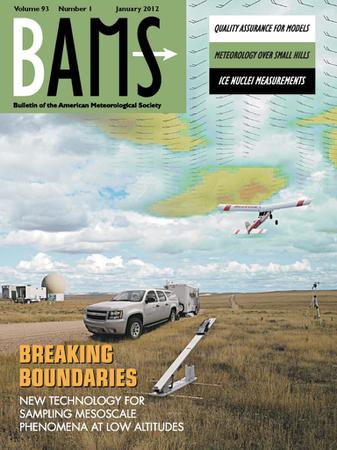南美洲对流层顶气溶胶层(SATAL)
IF 5.9
1区 地球科学
Q1 METEOROLOGY & ATMOSPHERIC SCIENCES
引用次数: 0
摘要
摘要利用现代气溶胶再分析研究与应用回顾分析第2版(MERRA-2)确定了南美洲对流层上层/平流层下层(UT/LS)气溶胶层的存在。这一层,我们称之为南美对流层顶气溶胶层(SATAL),是在亚马逊盆地上空11-14公里高度之间确定的。它表现出与亚洲对流层顶气体层(ATAL)和北美对流层顶气体层(NATAL)相似的季节性行为。从10月到次年3月,与南美季风的出现时间一致。它首先于10月在亚马逊盆地东部形成,然后移动到亚马逊南部,在那里它在12月至1月减弱,最后在2月至3月消散。我们假设两个主要因素影响UT/LS地区SATAL的形成:1)来自非洲的气溶胶来源;(2)南美洲季风系统活跃期来自深层对流系统的上升气流质量通量,将气溶胶输送到UT/LS。需要对气溶胶进行进一步的卫星观测和野外活动,以提供有用的信息,以查明南美季风期间UT/LS气溶胶的来源和组成。本文章由计算机程序翻译,如有差异,请以英文原文为准。
The South American Tropopause Aerosol Layer (SATAL)
Abstract The presence of an aerosol layer in the upper troposphere/lower stratosphere (UT/LS) in South America was identified with the Modern-Era Retrospective analysis for Research and Application Aerosol Reanalysis Version 2 (MERRA-2). This layer, which we shall refer to as the South American Tropopause Aerosol Layer (SATAL) was identified over the Amazon Basin at altitudes between 11-14 km. It exhibits a seasonal behavior similar to the Asian Tropopause Aerosol Layer (ATAL) and the North American Tropopause Aerosol Layer (NATAL). The SATAL is observed from October to March, coinciding with the presence of the South American monsoon. It forms first in the eastern Amazon Basin in October, then moves to the Southern Amazon, where it weakens in December-January and finally dissipates in February-March. We hypothesize that two main factors influence the SATAL formation in the UT/LS: 1) the source of aerosols from Africa; 2) the updraft mass flux from deep convective systems during the active phase of the South American Monsoon System that transports aerosols to the UT/LS. Further satellite observations of aerosols and field campaigns are needed to provide useful information to find the origin and composition of the aerosols in the UT/LS during the South American Monsoon.
求助全文
通过发布文献求助,成功后即可免费获取论文全文。
去求助
来源期刊
CiteScore
9.80
自引率
6.20%
发文量
231
审稿时长
6-12 weeks
期刊介绍:
The Bulletin of the American Meteorological Society (BAMS) is the flagship magazine of AMS and publishes articles of interest and significance for the weather, water, and climate community as well as news, editorials, and reviews for AMS members.

 求助内容:
求助内容: 应助结果提醒方式:
应助结果提醒方式:


